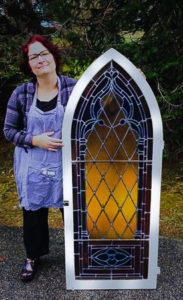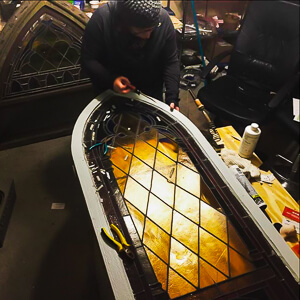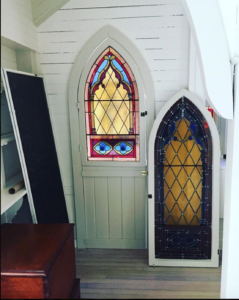by Dave Seifert
In the spring of 1899 the Rev. Charles E. Preston literally took the Chapel of the Transfiguration to people on Jamestown Island. Now, more than 100 years later, several stained-glass windows in that movable chapel are getting new life, thanks to a parishioner from St. Matthew’s Episcopal Church.
The artist, Jennifer Weeden-Black, was commissioned to restore the windows by the chapel’s current owners, George and Julie Lynch, who bought the building as their home. And the project, which began as a simple business transaction, is turning out to be transformational for Weeden-Black and even other parishioners at St. Matthew’s.
According to a 2013 Jamestown Press article, Preston’s idea was to take church to island-dwellers who found it difficult to get to St. Matthew’s — after all, automobiles were still rare in 1899. His idea was that for 10 months of the year, “it would sit about 3 miles north of the village and serve the year-round farm community,” states the article. “In the summer, it would be moved to the northernmost part of the island to serve the summer residents at Conanicut Park.”
It took 10 oxen to haul the structure, 18 feet tall and large enough to seat 100 people. It never actually reached the park but was used as a chapel for 10 years at a spot on East Shore Road. In 1933, it was purchased, moved to Harbor Street — by a tractor this time — and converted to a private home.
 Now Weeden-Black is spending 20-30 hours total restoring each window taken apart, piece by piece (https://www.islandesignglass.com/the-moveable-chapel/), fixing breaks, replacing aging lead and repairing weather damage.
Now Weeden-Black is spending 20-30 hours total restoring each window taken apart, piece by piece (https://www.islandesignglass.com/the-moveable-chapel/), fixing breaks, replacing aging lead and repairing weather damage.
“This project challenged me, inspired me and introduced me to aspects of stained-glass I had not previously considered,” she said.
Her family’s roots go back to the founders of Jamestown, and she had lived there as a young girl with her mother and brother before leaving for college. She returned in 2001 with her husband, Jason, and they joined St. Matthew’s in 2003. Now they’re committed parishioners who both have served in a variety of parish ministries.
Although being part of St. Matthew’s didn’t figure into her decision to accept the project, it has turned out to be an important part of the experience.
“To be offered a chance to preserve part of the St. Matthew’s story, even one that is part of a private collection, has truly been an honor,” she explained. “In completing the first series of windows, I have also increased my confidence and commitment as a glass artist, a resident and a parishioner.
“I can’t count how many of the senior members of our parish have come to me to share their memories of the stories he or she recalls of the chapel,” she continued. “While the chapel has not been an active part of the church for years, they seemed to know about it! After I started talking about the project, I encountered residents with copies of a book Preston published documenting the chapel’s construction and opening.”
She delivered and oversaw the installation of the first window in April, completed another in May and hopes to continues on with the work later in the fall. She believes what’s most significant about the chapel is what it represents about the time when it existed.

“Although Preston’s idea to bring the church to those unable to access it easily is not a new idea, even as it was at the turn of the 20th century, the way the still-growing Jamestown community came together to support one another in constructing and transporting the chapel is a testament of sorts on the importance of relationships,” Weeden-Black said.
“For me, in my 21st century world, after being diagnosed with breast cancer and finding myself with my family struggling to seek out relationships during the weakest months, our St. Matthew’s community came to us offering support in the form of prayer, meals, and much more.
“So, in working on this project to help preserve the chapel windows for the current owners I felt as if in some small way I was also preserving the idea of the chapel for future Jamestowners and the members of our parish,” she added. “It is part of the island history, our church’s history, and now part of my family’s history.
